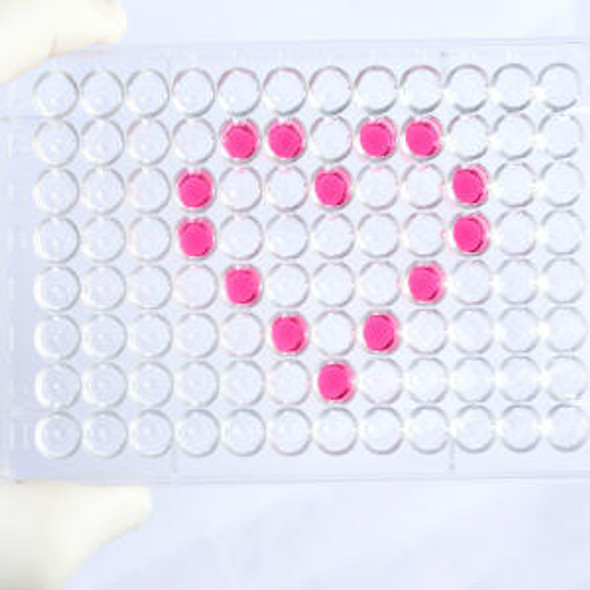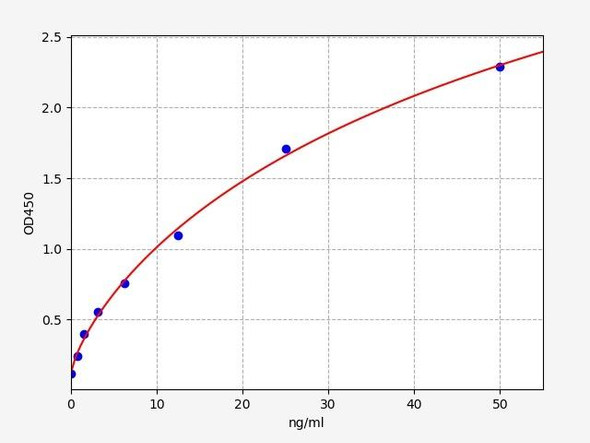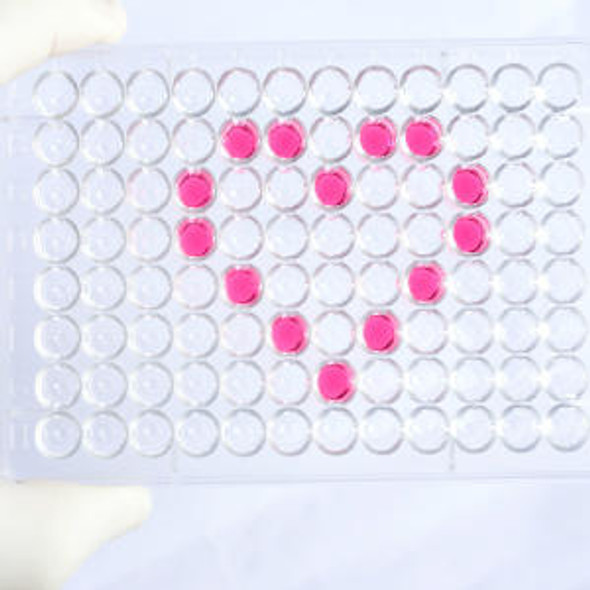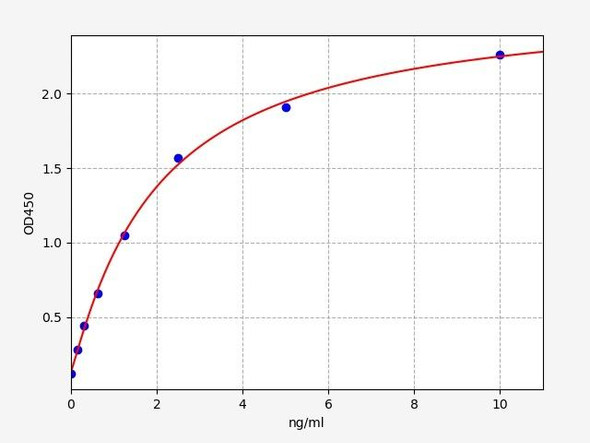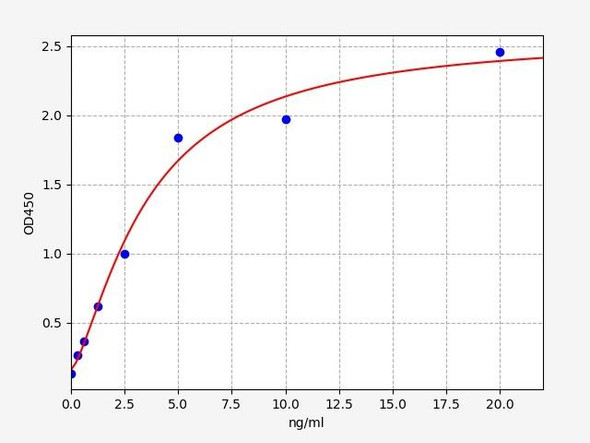Human RBPJ (Recombining binding protein suppressor of hairless) ELISA Kit (HUFI08556)
- SKU:
- HUFI08556
- Product Type:
- ELISA Kit
- Size:
- 96 Assays
- Uniprot:
- Q06330
- Sensitivity:
- 46.875pg/ml
- Range:
- 78.125-5000pg/ml
- ELISA Type:
- Sandwich ELISA, Double Antibody
- Synonyms:
- CBF 1, CBF1, csl, IGKJRB, IGKJRB1, KBF2, NY-REN-30, RBP J, RBP J kappa, RBP JK, RBPJ, RBPJK, RBPSUH, SUH
- Reactivity:
- Human
Description
| Product Name: | Human RBPJ (Recombining binding protein suppressor of hairless) ELISA Kit |
| Product Code: | HUFI08556 |
| Size: | 96 Assays |
| Alias: | CBF 1 ELISA Kit, CBF1 ELISA Kit, csl ELISA Kit, IGKJRB ELISA Kit, IGKJRB1 ELISA Kit, KBF2 ELISA Kit, NY-REN-30 ELISA Kit, RBP J ELISA Kit, RBP J kappa ELISA Kit, RBP JK ELISA Kit, RBPJ ELISA Kit, RBPJK ELISA Kit, RBPSUH ELISA Kit, SUH ELISA Kit |
| Detection method: | Sandwich ELISA, Double Antibody |
| Application: | This immunoassay kit allows for the in vitro quantitative determination of Human RBPJ (Recombining binding protein suppressor of hairless) concentrations in serum plasma and other biological fluids. |
| Sensitivity: | < 46.875pg/ml |
| Range: | 78.125-5000pg/ml |
| Storage: | 4°C for 6 months |
| Note: | For Research Use Only |
| Recovery: | Matrices listed below were spiked with certain level of Human RBPJ (Recombining binding protein suppressor of hairless) and the recovery rates were calculated by comparing the measured value to the expected amount of Human RBPJ (Recombining binding protein suppressor of hairless) in samples. | ||||||||||||||||
| |||||||||||||||||
| Linearity: | The linearity of the kit was assayed by testing samples spiked with appropriate concentration of Human RBPJ (Recombining binding protein suppressor of hairless) and their serial dilutions. The results were demonstrated by the percentage of calculated concentration to the expected. | ||||||||||||||||
| |||||||||||||||||
| CV(%): | Intra-Assay: CV<8% Inter-Assay: CV<10% |
| Component | Quantity | Storage |
| ELISA Microplate (Dismountable) | 8×12 strips | 4°C for 6 months |
| Lyophilized Standard | 2 | 4°C/-20°C |
| Sample/Standard Dilution Buffer | 20ml | 4°C |
| Biotin-labeled Antibody(Concentrated) | 120ul | 4°C (Protect from light) |
| Antibody Dilution Buffer | 10ml | 4°C |
| HRP-Streptavidin Conjugate(SABC) | 120ul | 4°C (Protect from light) |
| SABC Dilution Buffer | 10ml | 4°C |
| TMB Substrate | 10ml | 4°C (Protect from light) |
| Stop Solution | 10ml | 4°C |
| Wash Buffer(25X) | 30ml | 4°C |
| Plate Sealer | 5 | - |
Other materials and equipment required:
- Microplate reader with 450 nm wavelength filter
- Multichannel Pipette, Pipette, microcentrifuge tubes and disposable pipette tips
- Incubator
- Deionized or distilled water
- Absorbent paper
- Buffer resevoir
| UniProt Protein Function: | RBPJ: Transcriptional regulator that plays a central role in Notch signaling, a signaling pathway involved in cell-cell communication that regulates a broad spectrum of cell-fate determinations. Acts as a transcriptional repressor when it is not associated with Notch proteins. When associated with some NICD product of Notch proteins (Notch intracellular domain), it acts as a transcriptional activator that activates transcription of Notch target genes. Probably represses or activates transcription via the recruitment of chromatin remodeling complexes containing histone deacetylase or histone acetylase proteins, respectively. Specifically binds to the immunoglobulin kappa-type J segment recombination signal sequence. Binds specifically to methylated DNA. Interacts with activated NOTCH1, NOTCH2 or NOTCH3. Interacts with MINT/SHARP. This interaction may mediate the recruitment of large corepressor complexes containing proteins such as HDAC1, HDAC2, NCOR2, SAP30, FHL1/KYOT2 and CIR1. Interacts with EP300, MAML1 and PTF1A. Interacts with Epstein-Barr virus EBNA2, EBNA3, EBNA4 and EBNA6. Interacts with RITA/C12orf52, leading to nuclear export, prevent the interaction between RBPJ and NICD product and subsequent down-regulation of the Notch signaling pathway. Belongs to the Su(H) family. 7 isoforms of the human protein are produced by alternative splicing. |
| UniProt Protein Details: | Protein type:Transcription factor; Cell development/differentiation Chromosomal Location of Human Ortholog: 4p15.2 Cellular Component: nucleoplasm; transcription factor complex; cytoplasm; nucleolus; nucleus Molecular Function:protein binding; DNA binding; recombinase activity; protein N-terminus binding; chromatin binding; transcription factor activity Biological Process: somatic stem cell maintenance; myeloid dendritic cell differentiation; sebaceous gland development; negative regulation of transcription from RNA polymerase II promoter; DNA recombination; negative regulation of cell proliferation; negative regulation of ossification; angiogenesis; regulation of timing of cell differentiation; positive regulation of BMP signaling pathway; positive regulation of cardiac muscle cell proliferation; transcription initiation from RNA polymerase II promoter; epidermal cell fate specification; Notch signaling pathway; hair follicle maturation; humoral immune response; activation of Notch receptor target transcription factor; keratinocyte differentiation; inflammatory response to antigenic stimulus; pituitary gland development; B cell differentiation; defense response to bacterium; epithelial to mesenchymal transition; gene expression; positive regulation of transcription from RNA polymerase II promoter; blood vessel remodeling; auditory receptor cell fate commitment; negative regulation of transcription, DNA-dependent Disease: Adams-oliver Syndrome 3 |
| NCBI Summary: | The protein encoded by this gene is a transcriptional regulator important in the Notch signaling pathway. The encoded protein acts as a repressor when not bound to Notch proteins and an activator when bound to Notch proteins. It is thought to function by recruiting chromatin remodeling complexes containing histone deacetylase or histone acetylase proteins to Notch signaling pathway genes. Several transcript variants encoding different isoforms have been found for this gene, and several pseudogenes of this gene exist on chromosome 9. [provided by RefSeq, Oct 2013] |
| UniProt Code: | Q06330 |
| NCBI GenInfo Identifier: | 338817983 |
| NCBI Gene ID: | 3516 |
| NCBI Accession: | Q06330.3 |
| UniProt Secondary Accession: | Q06330,Q5XKH9, Q6P1N3, B4DY22, |
| UniProt Related Accession: | Q06330 |
| Molecular Weight: | 500 |
| NCBI Full Name: | Recombining binding protein suppressor of hairless |
| NCBI Synonym Full Names: | recombination signal binding protein for immunoglobulin kappa J region |
| NCBI Official Symbol: | RBPJ |
| NCBI Official Synonym Symbols: | SUH; csl; AOS3; CBF1; KBF2; RBP-J; RBPJK; IGKJRB; RBPSUH; IGKJRB1 |
| NCBI Protein Information: | recombining binding protein suppressor of hairless; CBF-1; RBP-JK; RBP-J kappa; H-2K binding factor-2; suppressor of hairless homolog; renal carcinoma antigen NY-REN-30; immunoglobulin kappa J region recombination signal binding protein 1 |
| UniProt Protein Name: | Recombining binding protein suppressor of hairless |
| UniProt Synonym Protein Names: | CBF-1; J kappa-recombination signal-binding protein; RBP-J kappa; RBP-J; RBP-JK; Renal carcinoma antigen NY-REN-30 |
| Protein Family: | RBPJ-interacting and tubulin-associated protein |
| UniProt Gene Name: | RBPJ |
| UniProt Entry Name: | SUH_HUMAN |
*Note: Protocols are specific to each batch/lot. For the correct instructions please follow the protocol included in your kit.
Before adding to wells, equilibrate the SABC working solution and TMB substrate for at least 30 min at 37 °C. When diluting samples and reagents, they must be mixed completely and evenly. It is recommended to plot a standard curve for each test.
| Step | Protocol |
| 1. | Set standard, test sample and control (zero) wells on the pre-coated plate respectively, and then, record their positions. It is recommended to measure each standard and sample in duplicate. Wash plate 2 times before adding standard, sample and control (zero) wells! |
| 2. | Aliquot 0.1ml standard solutions into the standard wells. |
| 3. | Add 0.1 ml of Sample / Standard dilution buffer into the control (zero) well. |
| 4. | Add 0.1 ml of properly diluted sample ( Human serum, plasma, tissue homogenates and other biological fluids.) into test sample wells. |
| 5. | Seal the plate with a cover and incubate at 37 °C for 90 min. |
| 6. | Remove the cover and discard the plate content, clap the plate on the absorbent filter papers or other absorbent material. Do NOT let the wells completely dry at any time. Wash plate X2. |
| 7. | Add 0.1 ml of Biotin- detection antibody working solution into the above wells (standard, test sample & zero wells). Add the solution at the bottom of each well without touching the side wall. |
| 8. | Seal the plate with a cover and incubate at 37 °C for 60 min. |
| 9. | Remove the cover, and wash plate 3 times with Wash buffer. Let wash buffer rest in wells for 1 min between each wash. |
| 10. | Add 0.1 ml of SABC working solution into each well, cover the plate and incubate at 37 °C for 30 min. |
| 11. | Remove the cover and wash plate 5 times with Wash buffer, and each time let the wash buffer stay in the wells for 1-2 min. |
| 12. | Add 90 µL of TMB substrate into each well, cover the plate and incubate at 37 °C in dark within 10-20 min. (Note: This incubation time is for reference use only, the optimal time should be determined by end user.) And the shades of blue can be seen in the first 3-4 wells (with most concentrated standard solutions), the other wells show no obvious color. |
| 13. | Add 50 µL of Stop solution into each well and mix thoroughly. The color changes into yellow immediately. |
| 14. | Read the O.D. absorbance at 450 nm in a microplate reader immediately after adding the stop solution. |
When carrying out an ELISA assay it is important to prepare your samples in order to achieve the best possible results. Below we have a list of procedures for the preparation of samples for different sample types.
| Sample Type | Protocol |
| Serum | If using serum separator tubes, allow samples to clot for 30 minutes at room temperature. Centrifuge for 10 minutes at 1,000x g. Collect the serum fraction and assay promptly or aliquot and store the samples at -80°C. Avoid multiple freeze-thaw cycles. If serum separator tubes are not being used, allow samples to clot overnight at 2-8°C. Centrifuge for 10 minutes at 1,000x g. Remove serum and assay promptly or aliquot and store the samples at -80°C. Avoid multiple freeze-thaw cycles. |
| Plasma | Collect plasma using EDTA or heparin as an anticoagulant. Centrifuge samples at 4°C for 15 mins at 1000 × g within 30 mins of collection. Collect the plasma fraction and assay promptly or aliquot and store the samples at -80°C. Avoid multiple freeze-thaw cycles. Note: Over haemolysed samples are not suitable for use with this kit. |
| Urine & Cerebrospinal Fluid | Collect the urine (mid-stream) in a sterile container, centrifuge for 20 mins at 2000-3000 rpm. Remove supernatant and assay immediately. If any precipitation is detected, repeat the centrifugation step. A similar protocol can be used for cerebrospinal fluid. |
| Cell culture supernatant | Collect the cell culture media by pipette, followed by centrifugation at 4°C for 20 mins at 1500 rpm. Collect the clear supernatant and assay immediately. |
| Cell lysates | Solubilize cells in lysis buffer and allow to sit on ice for 30 minutes. Centrifuge tubes at 14,000 x g for 5 minutes to remove insoluble material. Aliquot the supernatant into a new tube and discard the remaining whole cell extract. Quantify total protein concentration using a total protein assay. Assay immediately or aliquot and store at ≤ -20 °C. |
| Tissue homogenates | The preparation of tissue homogenates will vary depending upon tissue type. Rinse tissue with 1X PBS to remove excess blood & homogenize in 20ml of 1X PBS (including protease inhibitors) and store overnight at ≤ -20°C. Two freeze-thaw cycles are required to break the cell membranes. To further disrupt the cell membranes you can sonicate the samples. Centrifuge homogenates for 5 mins at 5000xg. Remove the supernatant and assay immediately or aliquot and store at -20°C or -80°C. |
| Tissue lysates | Rinse tissue with PBS, cut into 1-2 mm pieces, and homogenize with a tissue homogenizer in PBS. Add an equal volume of RIPA buffer containing protease inhibitors and lyse tissues at room temperature for 30 minutes with gentle agitation. Centrifuge to remove debris. Quantify total protein concentration using a total protein assay. Assay immediately or aliquot and store at ≤ -20 °C. |
| Breast Milk | Collect milk samples and centrifuge at 10,000 x g for 60 min at 4°C. Aliquot the supernatant and assay. For long term use, store samples at -80°C. Minimize freeze/thaw cycles. |



